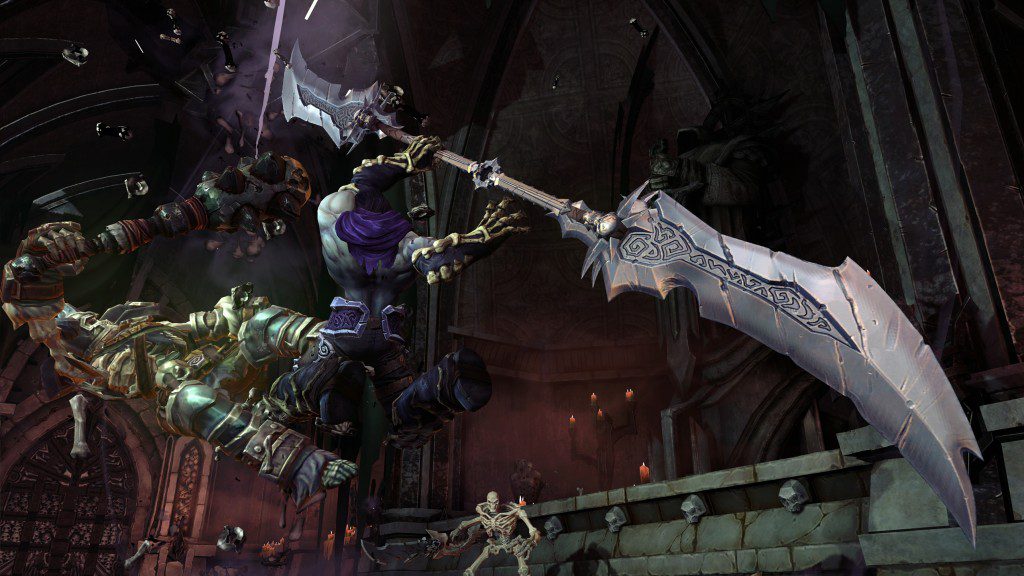In part 3 of our Darksiders II preview coverage I’ll be looking at the combat mechanics of the game, both in the context of the game as a whole and as a creature unto itself.
Third-person action games usually come in two flavors: slow and repetitive, which Darksiders fell into periodically, or overly complex and frustrating, like Bayonetta. This serves as a huge barrier for many players, either boring the combat connoisseurs or making things too difficult for those outside the fighting game sphere. The difference between Darksiders II and its contemporaries is the way puzzles, platforming, customization and combat work in tandem. However, standing on its own, the combat in Darksiders II is something to admire. Drawing heavily from fighting games like Tekken and Street Fighter as well as more traditional third-person action games like Devil May Cry and Bayonetta, Death manages to offer up a balanced approach that can be as scientific as arcade fighters or just a simple and fun piece to the overall puzzle.
Capcom’s seminal series Street Fighter is fairly ubiquitous, but I have trouble thinking of a game outside that genre that has managed to feel and play so much like a 2D arcade brawler. Yet, somehow, Lead Combat Designer Ben Cureton made it work brilliantly. Looking at the initial options of Light Attack and Heavy Attack it was hard to imagine that Vigil would be trying to redesign the wheel, but they are on the precipice of doing just that.
Factor number one for the combat is speed. As I mentioned in Tuesday’s coverage, Death is fast. Really fast. He doesn’t block, and instead dodges and leaps away to put space between himself and his enemies. Sure, he can take a beating, but that will get old very quickly. Instead of simply running up and pounding away, I was forced to think tactically. Jumping away from a mob and picking them off with different skills and weapons became a complex and satisfying experience, allowing me to find different ways of handling the same enemies based on what equipment I decided to use. Having an axe or warhammer on hand certainly deals prodigious and destructive blows, but it is also terribly slow. Putting on gauntlets, claws (a seemingly subtle but brilliant nod to Vega from Street Fighter), or tonfas allow for such quick combinations that your blows are almost imperceptible. Taking a slow, powerful and methodical approach will be tailor-made to some players, while the quick strike and dodge method will better fit the more reactionary. Deciding your pace of play is key early on in order to master Death’s abilities and get the most power out of your loadout.
Customization, which was covered in depth yesterday, also changes how your engagements with various beasts will go. Both skill trees offer different concepts, but both fit every play style, which was surprising. Powers like calling ghouls and crows to attack and distract your enemies work great for letting you get out of harm’s way and queue up your huge weapons, or you can let them tank for you while you dart in and out knocking out enemies one at a time at breakneck speed. The melee side allows for deeper combos and vicious attacks, perfect for quick strikes or as a way to disorientate and separate bad guys while you fire off huge hits. Every play style is catered to, and unlocking your perfect set up is almost a game on its own.
Where Darksiders II truly excels is its combos. That is where you can feel the hand of people who grew up tossing in quarter after quarter at the arcade memorizing and mastering characters. Death has a dizzying amount of combos, opening up dozens just in the first 6 levels I managed to achieve. Instead of relying on how and when you use the two attack buttons, nearly every button is used to diversify and enlarge your possibilities. Finding the set that is right for you and mastering them allows you to chain together ridiculous combinations well into the triple digits, which dodging graciously doesn’t break. Everything gels together smoothly, and you can input moves slightly ahead of Death just like you would in a fighting game. Setting up those chains and then quickly being able to react and avoid incoming attacks makes longer battles feeling like a single move. Once you have a grasp on the mechanics, the game seems to flow together at a rapid pace. Being able to run along a wall, leap to the adjacent ledge, landing in a group of enemies and then immediately starting an attack chain was one of the most exhilarating game moments I’ve had in years.
Darksiders II manages to avoid the standard “room and battle, next room and puzzle, next room and battle” routine so common in games, and I felt like I was constantly working at something new. There were no pauses or great gaps in my effect on the game world, no areas of simply running back and forth trying to find the next room I would get trapped in. Everything felt alive and connected in the world, and Death felt like a piece of the world instead of an outsider simply passing through. Each blow feels impactful and real, both those Death delivers and the pummelings dished out by enemies. There are few action titles that can boast such an accomplishment.
Fortunately, combat only has to be as complex as you want it to be, meaning that any level of player can get through the game and enjoy it. Having such a curve that doesn’t overly punish or reward one play type could not have been easy to manage, but here it is. I feel bad for games like God of War and DMC now, since they will have to reach the new bar Vigil has managed to set. Darksiders might become the new go-to franchise for action and combat.




